Ahu Tongariki: Moai 14-548-009
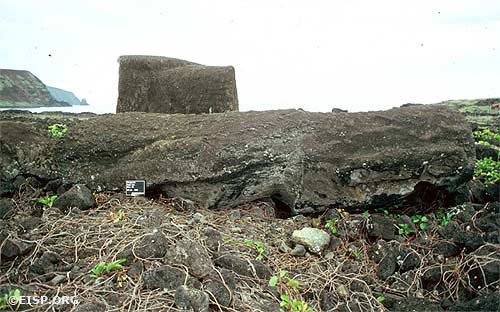
Prone Moai 14-548-009 on the unrestored site of Ahu Tongariki. The ahu was destroyed by a tsunami in 1960. © 1984 EISP/JVT/Photo: D.C. Ochsner.

Drawing of prone Moai RR-548-009 showing incised ‘tattoo’ lines on the neck. © 1992 EISP/JVT/Drawing: C. Arèvalo Pakarati.
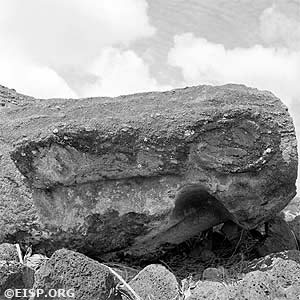
Detail of the broken right ear on Moai 14-548-009 at Ahu Tongariki © 1984 EISP/JVT/Photos: D. C. Ochsner.
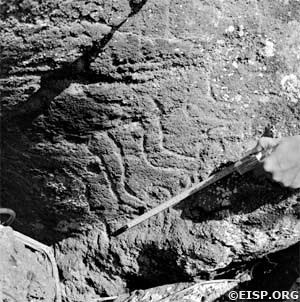
Incised lines on the neck of prone Moai 14-548-009 at Ahu Tongariki © 1984 EISP/JVT/Photos: D. C. Ochsner.
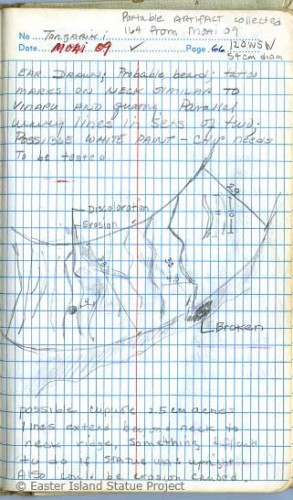
Pages from Jo Anne Van Tilburg’s field book detailing attributes of the right ear (left) and incised ‘tattoo’ on prone Moai 14-548-009. © 1984 EISP/Notes: J. Van Tilburg.
Bajorrelieve: Diseños dorsales
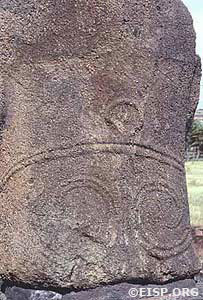
Bas-relief dorsal design on the back of an upright statue, Ahu Nau Nau, Anakena, Easter Island (Rapa Nui). DCO/JVT
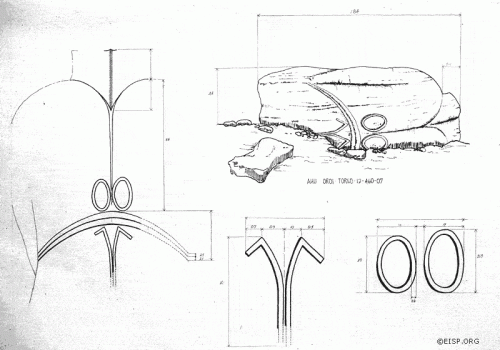
Detail of a similar but more complex design on the back of a fallen and broken torso, Ahu Oroi, Rapa Nui (Easter Island), 1983. Drawn by Raúl Paoa, EISP.
Cantera exterior de Rano Raraku: Dibujos de Moai y trazados de cuello (RR-002-077)
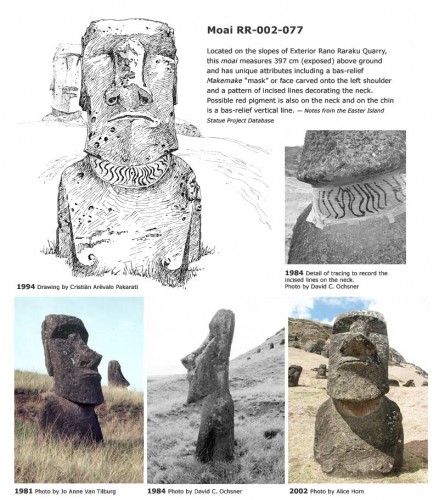
Moai RR-002-077 Situado en las laderas exteriores de la cantera de Rano Raraku, este moai mide 397 cm (expuestos) sobre el suelo y tiene atributos únicos, incluyendo una “máscara” makemake bajorrelieve o cara tallada en el hombro izquierdo y un patrón de líneas incisas que adornan el cuello. Posible pigmento rojo está también sobre el cuello y en la barbilla hay una línea vertical bajorrelieve. — Notas de la base de datos de Easter Island Statue Project
Historia de Easter Island Statue Project: 1981
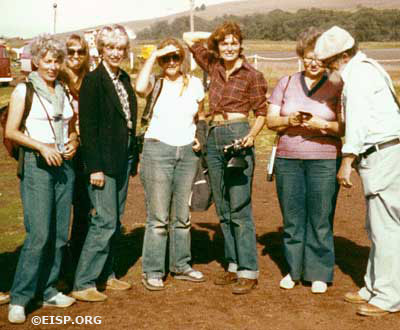
UREP Project Participants, Hanga Roa, Mataveri Airport, (left to right) Joan Seaver, Marcia Opel, Joanne Weinhof, Georgia Lee, Jo Anne Van Tilburg, Esther Schwartz, Ron Hoskinson. Photo by: Johannes Van Tilburg/EISP
En el verano del año 1981, Jo Anne Van Tilburg fue miembro del Programa de Expediciones de Investigación de la Universidad de California (UREP). Dirigido por Georgia Lee y realizada bajo los auspicios del Consejo de Monumentos de Chile, el objetivo del proyecto de voluntariado de seis semanas fue investigar la naturaleza y el alcance de corpus del arte rupestre de la isla de.
Registro de arte rupestre en la Isla de Pascua consistía en hacer fotografías y dibujos a escala en unos 25 sitios de petroglifos y un sitio pintado. Algunos sitios fueron dañados, y otros habían sido registrados previamente en una forma u otra. En los principales sitios turísticos de Anakena, Tongariki, y Orongo, hicimos calcos.
 English
English  Español
Español